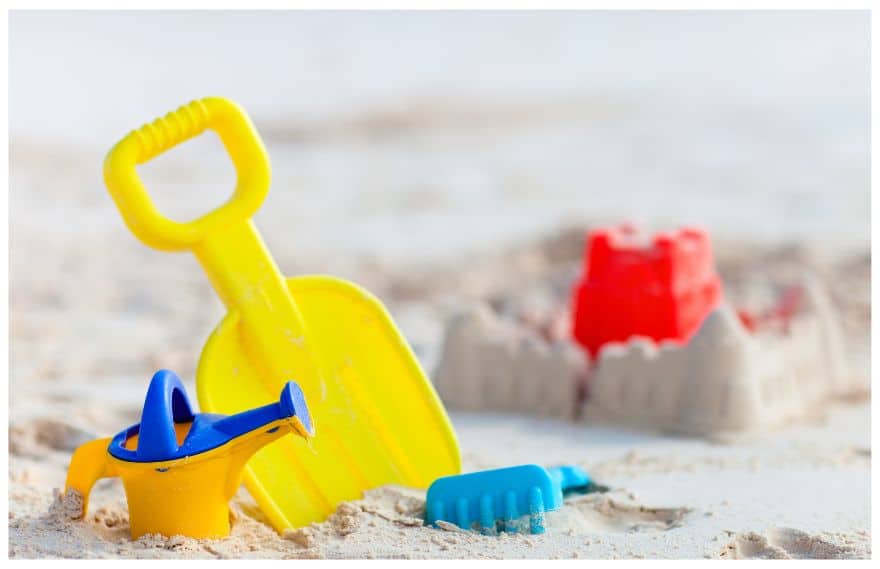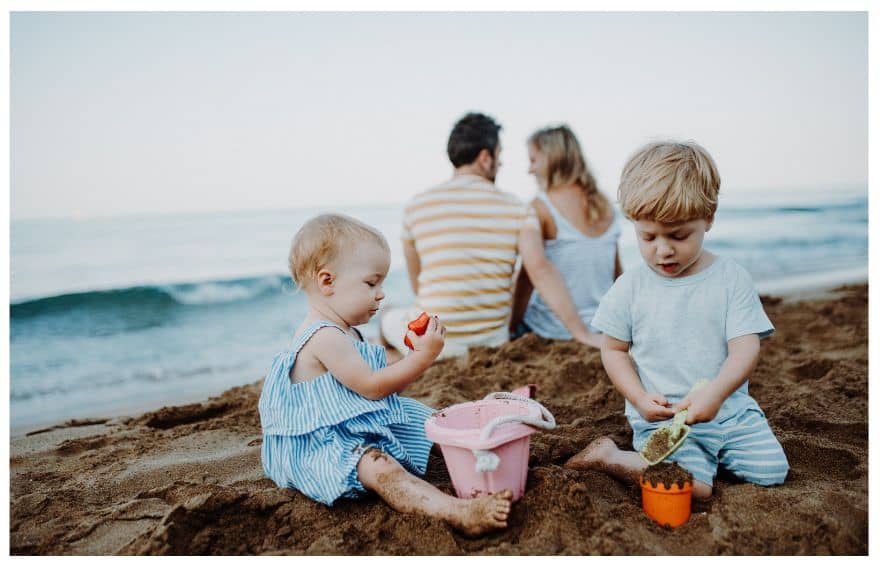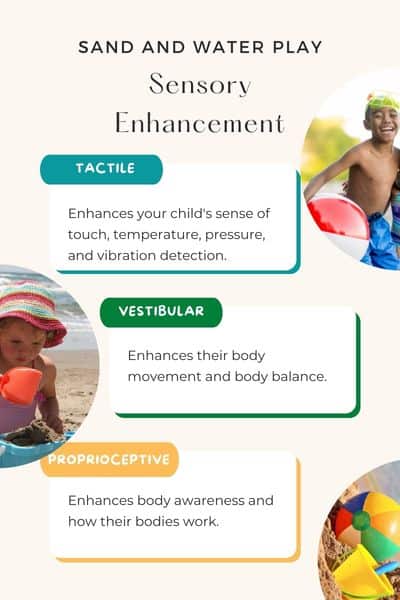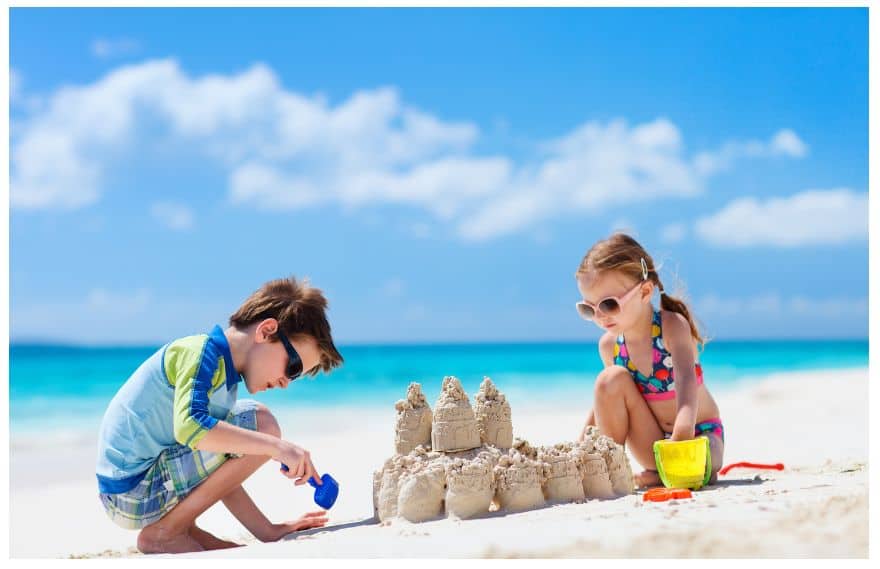The most fulfilling thing for a parent is watching their baby play with sand and water for the first time. You’ll enjoy watching them scoop sand and letting it trickle between their little fingers as it mixes with water. However, before you get worked up about the germs and dirty clothes, take a minute to consider the resounding benefits of sand and water play.
Sand and water play enhances sensory development, creativity, and develops curiosity. Sand and water play develops mathematical, language, social, and scientific skills. The sense of relaxation from playing releases endorphins to keep your baby happy.
What is Sand and Water Play?
Sand and water play involves kids playing with water and sand. Usually, kids will play using their hands or bodies, depending on the size of the play area. They can play together or separately, mixing the sand and water to create patterns and fun objects.

How Sand and Water Play Benefits Kids
1. Language and Vocabulary Development
Children build their vocabulary by experiencing new things and learning to describe and understand their actions. For example, as they play with sand and water, they have various tools, containers, and toys to build their vocabulary by describing how they use these items.
They further improve their sentence structure by engaging in conversations during playtime. Some new words they will learn include:
- Spade
- Bucket
- Funnel
- Shovel
- Pour
- Squeeze
- Swish
- Empty
- Full
- Wet
2. Improves Social Skills
Children are always energetic and loud when playing with siblings and peers. They learn how to manage conflicts amongst themselves and hold fruitful conversations when completing play tasks. Similarly, playing with water and sand calms children and enhances their social skills. Sand and water play is relaxing, and it influences how children interact with each other. These interpersonal skills will trickle into other areas of their life.

3. Tests for Hand-Eye Coordination
Hand-eye coordination is crucial for writing, sports, and other handy activities. For example, children who play with sand toys need their hands and eyes to work simultaneously to create and build structures.
Shoveling sand in a bucket or molding a sand castle requires much coordination and concentration in building their skills. Hand-eye coordination should be developed in the early years hence the need for a sandbox at home or school.
4. Better Grasp of Math and Science Concepts
Sand and water introduce kids to mathematical concepts like volume and measurement. For example, emptying two pails of sand into a bigger pail helps to identify which one holds more. Providing measuring cups enables them to understand how much it takes to fill a bucket.
Pouring water over sand introduces children to concepts like motion and water flow. If they are at the beach, teach them about living and non-living objects and animal habitats.

5. Gross and Fine Motor Development
Sand and water play stimulate a child’s small and large muscles. They will dig, pour, lift, scoop, and push sand at the beach or sandpit. These gross motor movements keep the large muscles active, strengthening the child’s body. Over time, they develop an awareness of their body and how they manage tasks.
Fine motor development refers to the small body muscles, especially the fingers. Children develop fine motor skills by learning how to control a pencil in formal schooling.
Whether in a sandpit or on the beach, they can improve the strength and control of their finger muscles. They do this by digging in the sand with their fingers or pouring water on wet sand to build shapes and add details.

6. Sensory Exploration
Children in the early years are still learning about their surrounding environment through their senses. In fact, that’s why child development experts encourage you to bring your kids along for hikes, evening walks, or beach trips.
Sand and water play is vital for sensory exploration as it engages your baby’s senses and improves their learning experience. There are three key sensory areas that will strengthen through sand and water play.
- Tactile Sense
This is a child’s sense of touch, temperature, pressure, and vibration detection. Playing with sand and water allows them to understand the difference between dry and wet sand.
- Vestibular Sense
This sense enables kids to understand body movement and balance over surfaces. For example, they will understand how to move weight without toppling over as they kneel in the sand with a shovel or bucket.
- Proprioceptive Sense
The proprioceptive sense is the awareness of how body parts work in a child’s surroundings. For example, vestibular senses work together when a child walks in a crowded room or uneven surface without looking down. Likewise, pushing toys through sand or unloading sand from buckets can significantly strengthen the senses.
7. Enhances Problem Solving Skills
Playing with sand and mud constantly exposes kids to problem-solving. They gradually understand the various factors in creating solutions to achieve a desirable outcome. When their sandcastle crumbles or when sand keeps falling off their shovel, they will find a way to make things better.
They will try to balance the sand and water proportions or carry a small amount of sand at once. Therefore, at this stage, their problems are merely obstacles they must work around to eradicate and succeed.

8. Enhanced Creativity
Early childhood specialists explain that heightened creativity supports a child’s mental flexibility in the long term. Therefore, exploring sand and water play lays a solid foundation for your child’s mental wellness.
Generally, sand and water play is very creative, encouraging children to create new objects and structures from a blank canvas (wet sand). They also develop creative ways to move sand and water around the play area.
For example, my daughters will tie a bucket on the rear of a toy vehicle and pull it from the bathroom to the outdoor patio. Kids always think of creative ways to have fun because they are natural creators.
9. Builds Concentration
As kids get creative with sand and water mixtures, they get fully absorbed into the activity. Sand and water play, therefore, builds their concentration and encourages them to focus on activities for prolonged periods.
As a result, they will perform better in class and other social settings. To further improve your child’s concentration level, introduce them to an activity book or puzzle, especially those related to water and sand play. After playing at the beach, I would always let my girls color, draw or solve puzzles about items they used or picked at the beach. This helped them build vocabulary and improved their concentration span.
It is not a must for you to be at the beach to expose your kids to the benefits of sand and water play. Get a sandbox or paddling pool to help them, or take them to waterways in local parks and school playgrounds.
Make it a habit to help your kids learn about their environment to strengthen their bodies and minds. As a parent, the fulfillment you get from seeing your child being creative is unimaginable.




